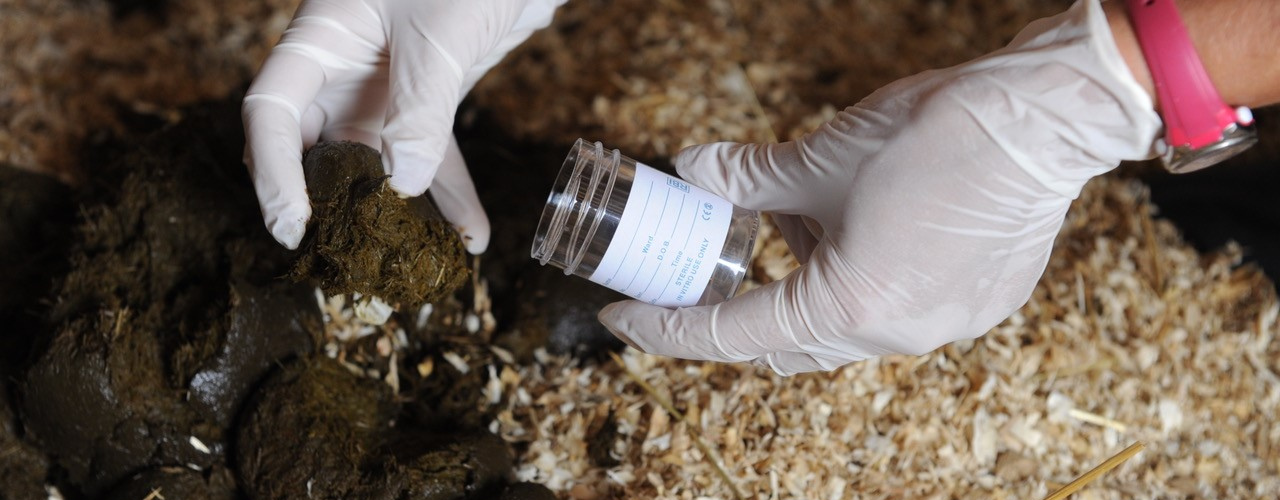
Assessing worm burdens with diagnostics
Diagnostic-led treatment utilises faecal egg counts (FECs) and antibody tests (either via saliva or blood), preferably with a year...
31 January 2024
Read More
Assessing worm burdens with diagnostics
The advantages of diagnostic-led treatment
Diagnostic-led treatment utilises faecal egg counts (FECs) and antibody tests (either via saliva or blood), preferably with a yearly risk assessment from a vet to inform the need for worming treatment. It has been shown to delay resistance development, with the largest delays shown in temperate climates.1
Available diagnostic tests
Faecal worm egg count FEC)
Faecal egg counts (FECs) are an important tool for worm control. They measure the number of worm eggs contained in a sample of your horse’s dung, to indicate the level of egg-shedding and whether or not your horse may need a wormer.
Parasite life cycles are linked to the seasons. The life cycle of most worms involves the horse inadvertently ingesting infective larvae from the pasture. These develop into adults in the horse’s digestive system and eggs are released and excreted (‘shed’) via droppings.
When should I conduct FECs?
Wet and warm spring or summer months present the ideal environmental conditions for the development of eggs and larvae on the pasture. This can lead to high pasture contamination and increase the potential for horses to acquire new parasite burdens, predominantly small redworms. It is why regular faecal egg counts (FECs) every 8-12 weeks from March to October, are so important.2
How do I conduct an FEC?
Collect a small sample of fresh dung from your horse. Because worm eggs are distributed unevenly within each pile of droppings it is best to collect a small pinch from at least five different faecal balls within a single dung pile.
Droppings used should be less than four hours old at the time of collection and the sample should be transferred to a plastic bag with as much of the air expelled as possible or filled to the top of an airtight container.
Samples should be kept cool and sent to a laboratory or your vet for testing as soon as possible to prevent any eggs hatching prior to counting.
At the laboratory or vet practice
There are a many different ways in which an FEC may be carried out - a commonly used method is the McMaster technique. At the laboratory the dung samples will be mixed with a flotation fluid and large clumps, such as grass, hay or straw will be filtered out. The sample is centrifuged, and the solid particles will settle to the bottom whilst the eggs float to the surface. The fluid containing the eggs is then collected using a pipette and placed in a counting slide where the eggs are identified and counted under a microscope.3
Which eggs are which?
Large and small redworm eggs look similar so are reported as strongyles. Small redworm are the most common worms to affect horses in the UK so these will constitute the large majority of strongyle eggs. Tapeworm eggs may be seen in FECs but the reliability of the routine methods used is low for this parasite and therefore they are not a definitive test for tapeworm. Ascarids are a common and significant finding in samples from foals and yearlings.3,4
Understanding the results
The number of worm eggs in the dung sample are measured and reported as eggs per gram (epg). Importantly, whilst an FEC can provide some indication of horses most at risk of parasitic disease it will not reliably correlate with the absolute number of worms a horse has. Instead, it shows how many eggs those worms are producing, and this could be different for each horse, even if they have the same burden.4
On this basis the aim of an FEC in adult horses is two-fold; to treat horses that may be at risk of parasitic disease and to reduce shedding to prevent further contamination of the pasture.
The standard level at which treatment is recommended is usually above 200epg of strongyles depending on the horse’s age and worming history. If you receive the result <50epg (no eggs seen) it doesn’t guarantee that there were no eggs in the sample as only a very small sample is studied under the microscope. However, it is likely to indicate that the horse is not currently shedding large numbers of eggs onto the pasture.4
What to do next
A single faecal worm egg count (FEC) is only a rough indication of your horse’s egg shedding at that time and results may vary between consecutive tests. FECs can help you to target your worming treatments by only dosing horses with significant egg-shedding, which will stop them from re-infecting the pasture for a period after the treatment. The horses with low egg counts are less in need of treatment as they are not contributing as many new worms onto the pasture. The test can also help you check that your wormer is working, if you take an FEC before and two weeks after administering a wormer – this is called a faecal egg count reduction test.4
Regular FECs during the grazing season will help to build a more consistent picture of your horse’s egg-shedding so that you can treat him accurately and keep him and the pasture healthy. Using regular FECs will save worming horses unnecessarily, helping to prevent the build-up of resistance to wormers.2
For advice on faecal worm egg counts always speak to your vet or RAMA/SQP.
Blood test
A blood test can be used to assess the presence of larval stages of the small redworm that won’t show up in a faecal worm egg count.5
Your vet will take a blood sample and use an ELISA immunological test to check for any small redworm infection. The test detects specific antibodies, which can give an indication of your horse’s intensity of infection.5
The test can be used in some situations alongside your horse's worm control history, age, health status, management and the environmental conditions before making a decision to treat your horse with a wormer. It is most useful in horses at low risk of infection to ‘rule out’ those needing a wormer at that time. It may also be useful to indicate if symptoms of colic could be associated with a small redworm burden.5
Saliva test
This test is used to detect the presence of tapeworm. It works in a similar way to a blood test but with the advantage that the horse owner can take the saliva sample using a special testing kit. The ELISA method is used to measure the specific antibodies to tapeworm parasites. The saliva sample is posted to the laboratory for analysis and the results sent to the owner together with advice for next steps if any treatment is needed. The recommendation is to test twice yearly for tapeworm. The same test can also be performed on a blood sample if required.,6,7,8,9
MM-25457

Diagnostic-led treatment utilises faecal egg counts (FECs) and antibody tests (either via saliva or blood), preferably with a year...
31 January 2024
Read More
A brief explanation of what resistance is, why it matters for horse owners, and how it can be managed by using wormers correctly a...
23 May 2023
Read More
A brief explanation of what resistance is, why it matters for horse owners, and how it can be managed by using wormers correctly a...
23 May 2023
Read More